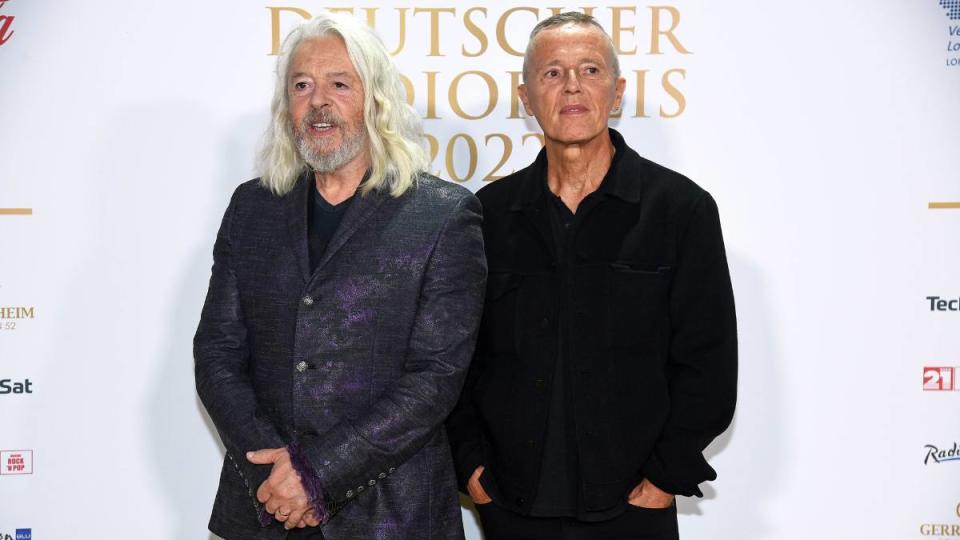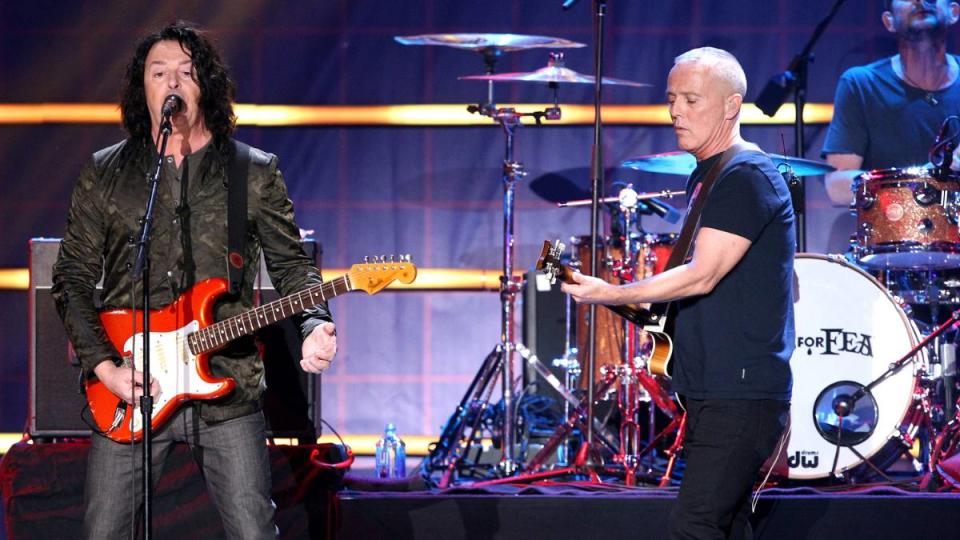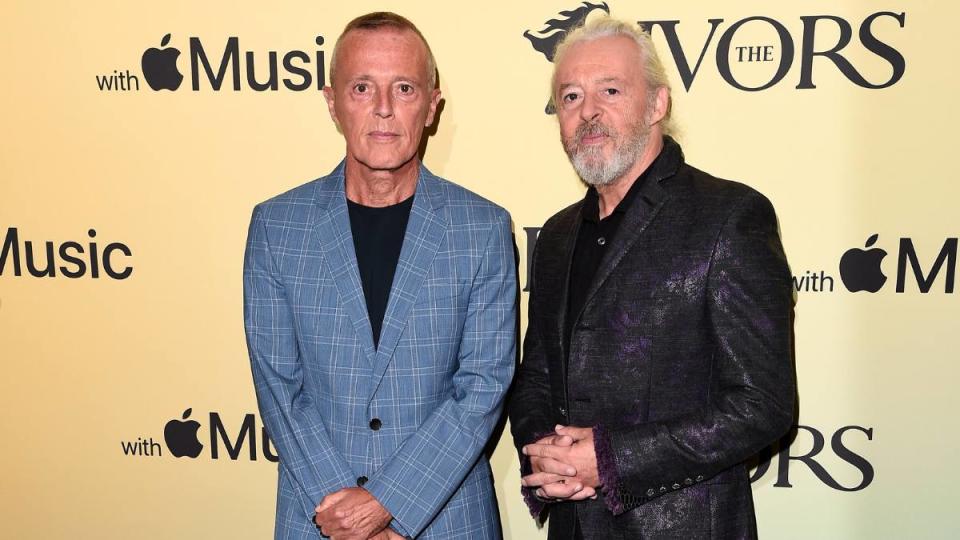Tears for Fears Songs: 14 Classic Tracks, Ranked
- Oops!Something went wrong.Please try again later.
- Oops!Something went wrong.Please try again later.
Grab a seat — or, better yet, a Big Chair — to catch up with Tears for Fears. The new wave band founded by Roland Orzabal and Curt Smith in 1981 have sold more than 30 million Tears for Fears songs over the past four-plus decades and, despite a split in the 90s, have stayed relevant thanks to their songs being covered by acts such as Lorde and sampled by the likes of Drake, The Weeknd, and more.
“You can be out of fashion and suddenly people are sampling you and covering you and then you’re kind of hip again,” Smith told The New Cue, quipping, “But this is what happens if you stay alive and stay around long enough, you will come back into fashion at some point!”
MUST-READ: 60 Years of Beatlemania: 10 Fab Beatles Moments From 1964

Tristar Media / Contributor / Getty
Fans of Tears for Fears songs, of course, will argue the band never went out of vogue. Their faithful followers proved just that by going head over heels (wink!) when the guys headlined a 2022 world tour in support of The Tipping Point, their first album in 18 years. In its first week out, it grabbed the No. 1 position on Billboard’s Top Alternative and Top Rock Albums charts, and it also went all the way to No. 8 on the Billboard 200, their highest placement there since 1989’s The Seeds of Love.
This most recent success came after a series of frustrating years for the duo. “We were so ushered into this modern way of making a record, which is not to trust the artist to write all the songs, but to trust…these young, hip songwriters, who that’s all they do for a living is churn out pop hits,” Orzabal told SPIN of having “our own trademark sound…regurgitated by these people and then shown back to us.”
MUST-READ: Greatest Rock Bands of All Time, Ranked: This List Will Have You Going “Crazy”

Tommaso Boddi / Contributor / Getty
Luckily, they eventually remembered what made them unique. “We’re really an album band,” Smith explained to Apple Music. “We sat down, just the two of us, with two acoustic guitars, and tried to forge a path forward. It felt more honest, and the material at the end of it was far better, probably because it was more honest.”
Smith notes that their latest is his favorite album of their entire career, and Orzabal is rather impressed himself. “I think we’ve managed to be quite clever…There are lots of clever nods and winks, which fans will get,” he noted to SPIN of certain tracks harkening back to earlier Tears for Fears songs.
Standout tunes include “Long, Long, Long Time,” “Rivers of Mercy,” and “Break the Man,” plus the sweeping and epic opening track “No Small Thing,” which Smith says “is definitely a journey, and albums for us should be a journey.” Sadly, much of Orzabal’s personal journey leading up to the album was quite hellish.

Eamonn M. McCormack / Stringer / Getty
“For a long period of making [The Turning Point], my wife [Caroline], my late wife now, had descended into mental illness and alcoholism, to put it simply. She was a previous beautiful, sexy, fiery woman,” he told SPIN of the life partner he lost in 2017, when Caroline was just 54. “I saw her become a ghost of a former self…but you never really believe, you never truly believe they’re going to die. You just think it’s going to carry on like this forever. The question is, will you ever know when it’s the tipping point, will you ever know when that person is on the threshold of death?,” he reflected, highlighting the song and the album title’s deeper meaning.
Powerful emotions and introspective lyrics have always been a trademark of the best Tears for Fears songs. Here, we revisit some of the top tracks from the duo’s earlier decades.
MUST-READ: Eagles Band Members: See The Country Rockers Then and Now
14. “Change” (1983): Tears for Fears songs
“Where does the end of me become the start of you?” Though it was a big hit for them — and their first to ever chart here in the U.S. — this is one of the poppier, most lightweight tunes in their repertoire, the guys have said. Still, it’s a fun listen, and Under the Radar calls it a “superb [example] of post-punk pop [that] motors along on the simplest of basslines and adds a little grit to the gloss of the rest of the album.”
13. “Advice for the Young at Heart” (1990)
“Love is a promise, love is a souvenir. Once given, never forgotten, never let it disappear.” This song “expresses a desire to grow up and get things together – to let go of the past,” Orzabal has said, adding, “I think it’s just an awareness of getting older…and also an awareness that certain aspects of you aren’t getting older.”
12. “Memories Fade” (1983): Tears for Fears songs
“Goodbye my friend. Will I ever love again? Memories fade but the scars still linger.” Many of The Hurting's songs, including this one, were inspired by the theories and writings of California psychotherapist Arthur Janov, who’s credited with developing primal scream therapy. Such heady inspiration led “Memories Fade” to be an “incredibly wordy song,” Orzabal has admitted, but listeners nonetheless responded to it and the album went to No. 1 in the U.K.
11. “The Hurting” (1983)
“Could you ease my load? Could you see my pain? Could you please explain the hurting?” Forty-plus years after its release, teens are reacting to and embracing this song on social media today, which actually doesn’t surprise the band. As Orzabal has noted, “[When we made it] we were struggling in that passage from childhood to adulthood, leaving your parents behind and becoming more self-sufficient, becoming an individual. That’s a universal period of turmoil.”
MUST-READ: Aerosmith Songs, Ranked: Rock Out to 12 Essential Hits by “The Bad Boys From Boston”
10. “I Believe” (1985): Tears for Fears songs
“I believe that when the hurting and the pain has gone, we will be strong.” Orzabal bravely bares his soul — and his chest, in the video — while singing this beautiful ballad. “I think that they are the most potent and powerful lyrics we’ve ever put onto vinyl,” he’s said about the heartfelt song.
9. “Pale Shelter” (1993)
“How can I be sure when you don’t give me love (you give me pale shelter). You don’t give me love (you give me cold hands).” Thedrawing “Pale Shelter Scene” by artist Henry Moore gave Orzabal’s tune its title, and he’s described it as “kind of a love song, though more referring to one’s parents than to a girl.” Smith sings lead on it, however. “If it’s a softer song it’s normally me.… My voice is a lot darker, a lot more melancholic,” Smith told The Quietus. While “Pale Shelter” is ultimately a pop track, “[it] wanted to be more melancholic and softer, and that’s my voice.”
8. “Mothers Talk” (1986): Tears for Fears songs
“When the wind blows, when the mothers talk, when the wind blows, we can work it out.” Talk about a creative hodgepodge! The opening’s sampled strings section came from a Barry Manilow song, while the lyrics were inspired by When The Wind Blows by Raymond Briggs, a graphic novel about a British couple surviving in the wake of a nuclear attack. Somehow it just works!
7. “Woman in Chains” (1989)
“Trades her soul as skin and bones, sells the only thing she owns.” The band happened upon Oleta Adams paying her dues in a hotel in Kansas City when they were blown away by her talent. They called the hotel two years later for her contact info, leading to her being featured on this track and touring with them all over the world. Orzabal “had written [‘Woman in Chains’] and he asked me to bring that same emotion to his song,” Adams has shared, adding, “It was the first time that I actually learned to love my voice.”
6. “Break It Down Again” (1993): Tears for Fears songs
“When it’s all mixed up, better break it down.” This single was released during the period in which Smith had temporarily left the band. “A lot of the songs [on 1993’s Elemental album] were written while I was in a sense going through the ‘divorce,’” Orzabal told The Washington Post. “Things like ‘Break It Down Again’ refer to that to some degree.”
5. “Mad World” (1992)
“When people run in circles it’s a very very mad world.” Orzabal penned this one at a time when he didn’t have a job. “It’s a bizarre viewpoint to watch people go about their daily routine, having to work for a living, when you’re sitting in a flat, unemployed,” he told a European radio show. The tone and message still resonates with younger generations today who are hearing the song for the first time. “If you’re writing from the heart, and you’re writing with honesty, I think that’s why music lasts a long time,” Smith told The Current of why this gem remains popular with newer fans.
4. “Head Over Heels” (1985): Tears for Fears songs
“Don’t take my heart, don’t break my heart, don’t, don’t, don’t throw it away.” This No. 3 hit “is probably the closest we’ll ever get to a love song,” Orzabal has quipped, even though he notes that “it goes a bit perverse at the end.” The video was an MTV staple when it came out, and — fun fact! — it was directed by the same man — Nigel Dick — who’d go on to direct Britney Spears’ “…Baby One More Time” more than a decade later.
3. “Sowing the Seeds of Love” (1989)
“High time we made a stand and shook up the views of the common man.” This 60s-sounding smash — inspired by The Beatles’ “I Am the Walrus” — hit No. 2 on the charts. “That song was always a joy. There was something light-hearted and magical about the track that made it stand out,” Smith told Classic Pop magazine.
2. “Shout” (1985): Tears for Fears songs
“Shout, shout, let it all out. These are the things I can do without.” With its catchy mantra-like chorus, as Orzabal has described it, this song proved to be irresistible to those hearing it on the radio and on MTV in the 80s. “There were so many protest singles, and I think…‘Shout’ was the most direct of all them,” he’s also noted about the No. 1 hit not being another tune inspired by primal scream theory (as many assume), but rather an antiwar statement and a reflection on people’s Cold War fears.
1. “Everybody Wants to Rule the World” (1985)
“Welcome to your life; there’s no turning back.” Instantly identifiable from the first couple of notes, this song was the band’s first to hit No. 1 here in the U.S. As far as pop songs go, its subject matter is “quite serious – it’s about everybody wanting power, about warfare and the misery it causes,” Smith has said. While the lyrics might tackle some dark and scary subjects, the song magically maintains a “musical innocence, specifically [with] its irregular tempo,” as Consequence of Sound explains, going on to call it “a timeless and influential composition.”

